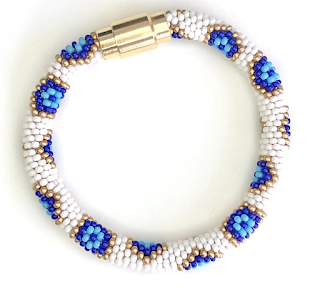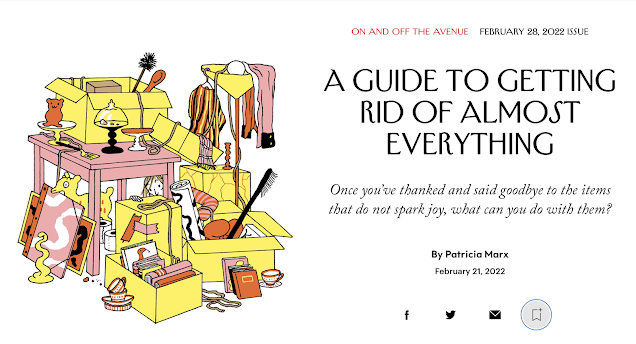Relaxed fashion: If "I'm not going back", what's the forward?
Rhonda Gherlick's article "Am I Done Suffering for Fashion?" in the New York Times' Style section, published on April 18, says it all: "...relaxed fashion tends toward solid colours (no patterns to mix or match), easier sizing, fabrics that work well together and far fewer “levels” to fuss with (casual, professional and dressy all sort of meld together). In other words, relaxed fashion offers low-stress “uniform” dressing for women."
This pivot requires fewer items (I once had heels dedicated to a single outfit), and costs far less to maintain. Gerlick quotes Christine de Lassus, age 58, "who says that she adopted long ago 'sportswear/streetwear/oversized/minimalist/comfortable' fashion that seems to be the new norm."
Relaxed work wear—even in actual offices— embraces elastic-waist trousers, wire-free bras and a rejection of tighter cuts such as pencil skirts and fitted blazers. According to another article, "the ratio of elastic-waist work pants to those with buttons or zippers on Stitch Fix was one to one in 2019; now it’s three to one."
Once a driver of scorn (Hillary Clinton's pantsuits), uniform dressing now earns respect; a woman in the article speaks happily of ordering multiples of the same trousers from Eddie Bauer.
If the past two years' change is permanent, what's next? I see three possibilities.
1. Adaptive clothing will go mainstream. Design features in these pieces help persons cope with arthritic hands, restricted range of motion, or mobility issues. Elastic waists were the gateway, but as the population ages, they will continue to seek less-confining clothes and accessories. I'd wear this beaded "Athens" bracelet with a chic magnetic clasp from June Adaptive in a heartbeat!
 |
| Photo: JuneAdaptive.com |
Toronto's Izzy Camilleri (IzAdaptive), makes perfect, sharp clothing like a denim shirt with magnetic snaps, $CDN 200. (I would also wear this as an overshirt.)
IzAdaptive sell the smart Billy footwear, with styles like these zip sneakers.
Surprise, the global brand Tommy Hilfiger has a Tommy Adaptive line! Once associated with enormous logos on blocky hoodies, now many of the brand's women's pieces use only a tiny signal-flag.
Below, two standouts: a sharp green-and-white striped cotton shirtdress, and a zipped jegging with interior features designed for seated wear.
2. Size range will reflect body diversity, though progress is gradual. A disappointing number of vendors still do not offer sizes above a US 10 or 12. (You, my beloved ça va de soi.) According to a 2018 study published on racked.com before the pandemic) 68% of American women wore a size 14 and up,
Hats off to Universal Standard for doing away with category names (the range runs from 0 to 32) and for putting a hip jacket like the Leeron leather moto out in 4XL.
Who else? Depends on what you mean by "size range". J. Crew offer what they call "extended sizes"; this ruched one-shoulder swimsuit comes in US sizes 0-24 and a gorgeous array of summer colours.
We don't just need an expanded size range, we need more realistic cuts for women who do not want skirts that end just south of their underwear, sleeves that don't feel like tourniquets, sweaters that are not cropped to expose the midriff. This is cost-cutting, not design, and we should call them on it.
Vendors already offer "curvy" trouser and jean cuts for women who need different waist-to-hip ratios, but where are the off-the-rack blouses for women with larger busts?
Diversity means more than just fulfilling the need for larger sizes. I have posted on gender-free clothing, which is ever easier to find, though too many brands offer the same generic sweats. (One of the good ones, Entireworld, failed even though earning fans during the most couch-intensive wave of the pandemic.)
3. More customers will seek quality.
The young'uns are deeply interested in sustainability; many have rejected fast fashion. When I visit exhibits like Charles James at the Met, or Thierry Mugler at our Museum of Fine Arts, I am thrilled to see patrons in their twenties admiring the artful construction and fabrics from the great French textile houses of the 1960s.
 |
| Christian Dior exhibit, Montreal Museum of Fine Arts |
There are, in such exhibits, details that someone under age 30 has likely not seen while shopping: the finished seam, precisely-finished buttonhole, impeccable lining.
In ready-to-wear, we have become inured to careless fabrication; even basic finishing has slipped. I recently bought a Diesel black turtleneck with four tiny covered buttons on each sleeve and had to re-attach every one.
To pay more for better quality—which for most means buying less— invites us to examine our brains on acquisition. If you haven't listened to the episode of Laurie Taylor's podcast series "Thinking Allowed", "The Value of Things: Why We Hang On to Objects", it's well worth the time. (Also on Apple Podcasts.)
Taylor's guest, Christine Harold, Professor of Communication at the University of Washington, observes that though Marie Kondo helps clients divest belongings, she does not address the root cause of over-buying: that our belongings meet needs for comfort, security and self-expression, even if ultimately they're just... stuff.
Whether minimalist or magpie, we all have those needs— and women are now looking more critically at how they attempt to fulfill them.








Comments
You mention having a dedicated pair of heels for a single outfit, and I've certainly been there. Also, different heel heights needed different trouser lengths (and vice versa, of course...) severely restricting wardrobe versatility. Now, all my footwear is minimal heel so no more fussing about there.
I also used to feel obliged to wear skirts. I am long-waisted and hated having to continually tuck in my top. Why did I persevere for so long? Goodness knows! I have not worn an actual skirt for well over 10 years and assuredly do not miss them.
Isn't it funny how wearing elastic-waisted trousers used to be taken as a shorthand for 'letting oneself go'. Partly due, I'm sure, to the blocky nature of the construction in those days; often just a literal elastic-threaded channel with no consideration given to how the garment would hang. The options are so much better now. I am a fan of (Danish brand) Robell trousers, which seem to provide me with all the advantages of an elastic-type waist but with the fit of fixed waist styling.
I gave up on ordinary jeans some years ago, too. I found the zip fly and metal stud fastening had become bulky and uncomfortable on my older body and it was always a nightmare to get them to tuck neatly into long boots or wellies. Good quality jeggings, worn in a size that fits neatly rather than skin-tight, work perfectly for me as 'skinny jeans'.
Perhaps we are working our way, very slowly, to the clothes Nirvana that has always been open to men. They've always had access to clothes that allow for more comfort and movement, in a realistic range of sizes and lengths, with attractive styles that endure and mitigate against 'wardrobe churn'.
Jane in London
Loved the podcast.
As far as men's clothes being more comfortable, I do think we are moving toward more equality but also so many men are indifferent to fit and wear shapeless khakis with a puddly polo. Last summer Jeanne and I were walking down the street when a man approached in a slim emerald-green suit with a pale blue shirt, and we stopped in our tracks and told him he looked fantastic. .
They must not be making profit from petite sizes, yet I see many women around my height.
Perhaps most offensively, I have shrunk 3/4 an inch & suspect there is no end in sight.
On a discussion of sustainability, one person said “I don’t know what the answer is” to landfills of clothes.
Of course we all know-stop buying too much.
I had the shoe/pants dilemma back in the day. Now I won’t buy any clothing or shoes that aren’t a good match for *at least* 5 items in my closet.
Ocd: Expanding the size range, and also providing Petite, Tall and Plus Petite, puts a demand on inventory. Madewell offer a number of styles in Petite. I have not worn heels t hat require longer trousers in so many years that I had forgotten about that whole shoe/trouser dilemma!